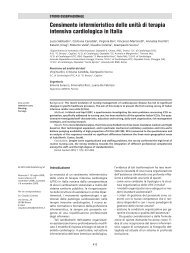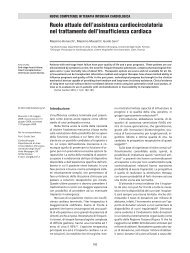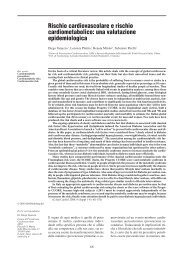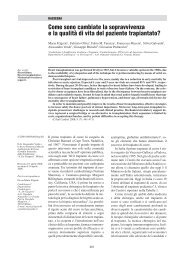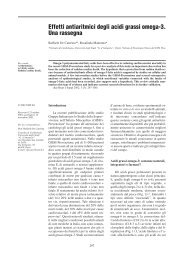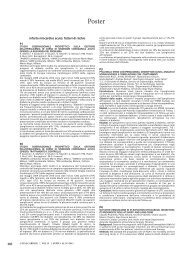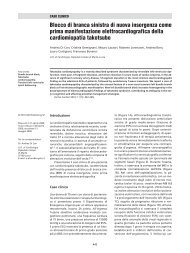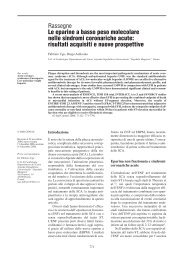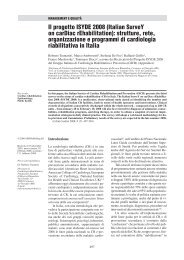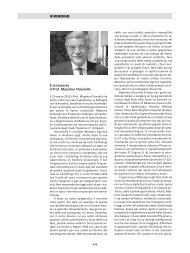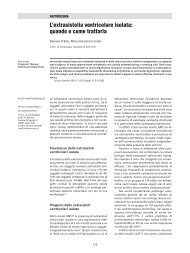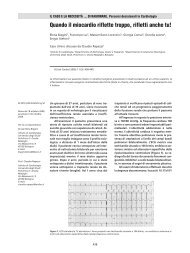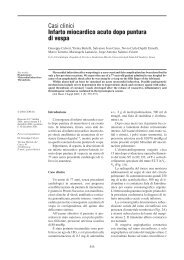COMUNICAZIONI - Giornale Italiano di Cardiologia
COMUNICAZIONI - Giornale Italiano di Cardiologia
COMUNICAZIONI - Giornale Italiano di Cardiologia
You also want an ePaper? Increase the reach of your titles
YUMPU automatically turns print PDFs into web optimized ePapers that Google loves.
G Ital Car<strong>di</strong>ol Vol 8 Suppl 2-5 2007<br />
demonstrated the advantage of early abciximab administration on pre-PCI<br />
patency rate of the infarct related artery (IRA), resulting in improved myocar<strong>di</strong>al<br />
reperfusion and clinical outcome. It is not known whether early abciximab<br />
administration influences myocar<strong>di</strong>al reperfusion and functional recovery in the<br />
subgroup of patients without pre-PCI optimal recanalization of the IRA (TIMI 3).<br />
Methods. Out of the 210 consecutive pts enrolled, 174 (83%) showed pre-PCI<br />
TIMI flow rate 4, pre-hospital delay> 2 hrs, pretreatment<br />
delay >2 hrs, and age classes, were not significant. At 5-year follow-up,<br />
mortality resulted significantly correlated with IRV flow before PCI (log rank<br />
p=0.04).<br />
survival<br />
1,0<br />
0,9<br />
0,8<br />
0,7<br />
0,6<br />
0,5<br />
SURVIVAL ACCORDING TO IVR PATENCY BEFORE PCI<br />
TIMI 3= 87%<br />
TIMI 2= 82%<br />
TIMI 0/1= 67%<br />
0 20 40 60 80<br />
follow up (months)<br />
Conclusions. In a real world population, when organizational characteristics and<br />
time delays significantly <strong>di</strong>ffer from RCT, a timely strategy of thrombolysis<br />
followed by PCI (facilitated or rescue) warrants a better IVR patency compared to<br />
the patients receiving a later pPCI, and this possibly explain the better 5-year<br />
survival.<br />
Infarto miocar<strong>di</strong>co acuto: stratificazione prognostica<br />
C92<br />
ELEVATION OF GAMMA-GLUTAMYLTRANSFERASE LEVELS IN DIABETIC<br />
PATIENTS SUFFERING FROM AN ACUTE MYOCARDIAL INFARCTION: AN<br />
INDEX OF ADVERSE OUTCOME<br />
S. Patanè*, F. Marte*, G. Di Bella**, R. Romeo*** , G. D’Andrea****, R. Giuffrè*,<br />
A. Currò*, R. Parisi*<br />
*Car<strong>di</strong>ologia, Nuovo Presi<strong>di</strong>o Ospedaliero Cutroni Zodda-Barcellona P.D.G.<br />
(ME), AUSL 5 Messina, **Car<strong>di</strong>ologia Policlinico Univ. Messina, ***Car<strong>di</strong>ologia,<br />
Ospedale Giarre AUSL3, Catania, ****Diabetologia, Ospedale Milazzo AUSL 5,<br />
Messina<br />
Aim of the study. The pathophysiological dysfunction of protein kinases C<br />
(PKCs) signaling pathways underlies the molecular basis of several<br />
car<strong>di</strong>ovascular responses. In experimental models in obese <strong>di</strong>abetics animals<br />
significant inhibition of insulin-induced glucose uptake, significant increase of<br />
Reactive oxygen species (ROS),of basal glucose uptake and of activity of delta<br />
PKC have been reported.The hypothesis that increased glucose intake increases<br />
oxidative stress, which in turn promotes the activation of delta PKC and that<br />
ad<strong>di</strong>tional mechanisms may be operating to produce ROS under hyperglycemic<br />
con<strong>di</strong>tions, inclu<strong>di</strong>ng the formation of advanced glycation end products or<br />
activation of oxidases such as NADPH oxidase have been reported too. Gammaglutamyltransferase<br />
(GGT) regulates PKC activity and its physiologic role is to<br />
initiate the hydrolysis of extracellular glutathione (GSH). It has also been reported<br />
GGT iron-dependent LDL oxidation and that the products of the GGT irondependent<br />
reaction may themselves lead to increased free ra<strong>di</strong>cal production.<br />
There is some evidence from recent stu<strong>di</strong>es that GGT is independently<br />
associated with car<strong>di</strong>ovascular mortality. Aim of this study was to investigate if<br />
there were relations among higher GGT levels, ejection fraction and adverse<br />
car<strong>di</strong>ac events in <strong>di</strong>abetic patients with Acute Myocar<strong>di</strong>al Infarction (AMI) and<br />
without renal failure.<br />
Methods. We stu<strong>di</strong>ed, in a retrospective analysis,140 <strong>di</strong>abetic patients with AMI<br />
[94 patients with Non-ST-Segment Elevation Myocar<strong>di</strong>al Infarction (NSTEMI) and<br />
36 patients with ST-Segment Elevation Myocar<strong>di</strong>al Infarction (STEMI)], <strong>di</strong>vided in<br />
two groups accor<strong>di</strong>ng to decrease of GGT (108 patients, named dGGT group) or<br />
elevation of GGT (32 patients, named eGGT group) during hospitalization for<br />
AMI. So we fixed a simple endpoint (Recurrent AMI, Heart Failure, Death) within<br />
ten months from hospitalization and a composite endpoint with at least a single<br />
adverse event.<br />
Results. We found significant correlations as follows:<br />
eGGT group (32pt) dGGT group (108pt) P value<br />
Recurrent AMI 34,375% (11/32pt) 5,555556% (6/108pt)



